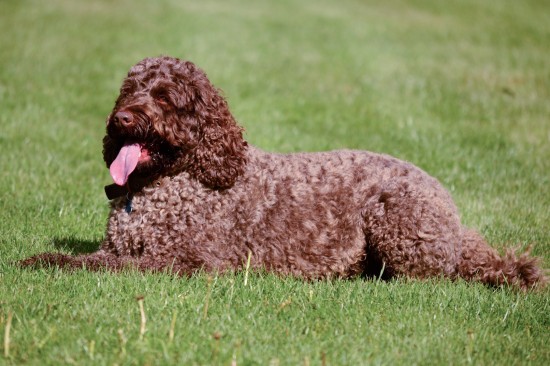


The Labradoodle is a hybrid or cross breed dog, which is created from the crossing of a Labrador retriever and a poodle, generally a standard poodle, which is the largest of the three types. While the Labradoodle is not actually classed as a pedigree breed in its own right and is still technically referred to as a crossbreed, the popularity of the Labradoodle in the UK today means that they are instantly recognisable, and actually a much more common sight than many other genuine pedigree breeds.
The size of the Labradoodle will vary depending on the size of the parent dogs, and specifically, what size of poodle is used in the crossing, but they do tend to be on the large side, and are well balanced, handsome looking dogs with a distinctive coat that tends towards the curled poodle coat style. They can be found in a wide variety of colours, and while they are not recognised by The Kennel Club, many enthusiasts and breed organisations are very active in working to raise the profile of the Labradoodle, and promote their ownership.
If you are wondering if the Labradoodle is the right choice of dog for you, it is important to look into the core traits of the breed in detail before buying, and this includes finding out as much as possible about the hereditary health and diversity of the type as a whole. In this article, we will look at these considerations in more detail. Read on to learn more.
The average lifespan of the Labradoodle as far as figures can be ascertained is 12-14 years, which places this hybrid breed towards the top of the rankings across the board for dogs of a similar size and build.
However, because The Kennel Club does not register Labradoodles, no formal figures are currently collated for the mean lifespan across the type as a whole.
The Labradoodle benefits from the advantages of hybrid vigour, which are achieved by the crossing of two unrelated dog breeds such as the Labrador and the poodle. However, there are various different ways to “make” a Labradoodle, including crossing a Labrador with a poodle, crossing a Labradoodle back to either a Labrador or a poodle, and crossing two Labradoodles themselves.
Because the number of Labradoodles, Labradors and poodles within the UK is relatively high, inbreeding should not be considered necessary in order to keep the Labradoodle dog type viable in perpetuity. Breeders of Labradoodle dogs are strongly advised to keep the coefficient of inbreeding figure for their breed lines below 6.25%, in order to ensure the health and viability of the type in perpetuity.
The Labradoodle is a handsome and well balanced dog, whose build is not considered to be subject to exaggerations or overtyping. However, the poodle-like coat of the Labradoodle does need regular brushing, grooming and potentially trimming, to keep it in good condition and ensure that it does not become overly long and tangled.
While the Labradoodle is not a pedigree dog breed, organisations such as the British Veterinary Association do not pretend that the type doesn’t exist! As such, certain health conditions that are hereditary within Labrador and poodle gene pools can also affect the Labradoodle, and the British Veterinary Association and Labradoodle Trust recommend health screening for certain conditions prior to breeding.
Recommended screening programmes for the Labradoodle are:
Despite the benefits of hybrid vigour and genetic diversity within the Labradoodle type as a whole, the breed is also known to have a slightly elevated propensity to developing a small range of hereditary health conditions, which originate within the Labrador retriever and poodle breeds respectively.
While no tests are offered for conditions other than those listed above, Labradoodle owners and potential owners are advised to appraise themselves of the possibility of the following health conditions:
As well as these conditions that have been identified as occurring within the Labradoodle gene pool, Labradoodle owners are also advised to research the general health of both the Labrador retriever and poodle dog breeds, as conditions that are prevalent in either of the parent breeds may potentially affect the Labradoodle too.
Copyright © 2005-2016 Pet Information All Rights Reserved
Contact us: www162date@outlook.com